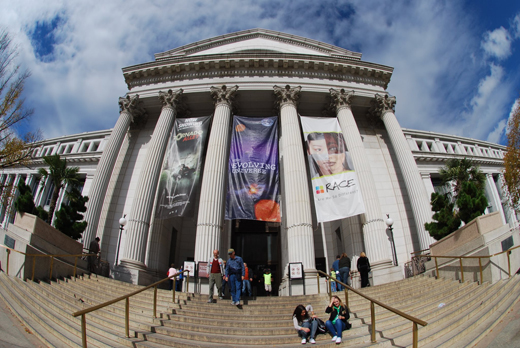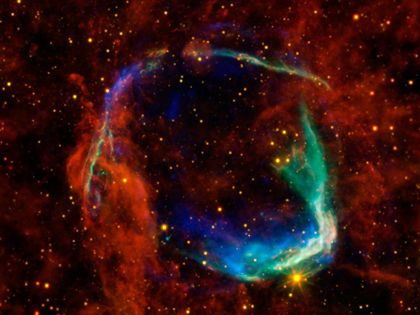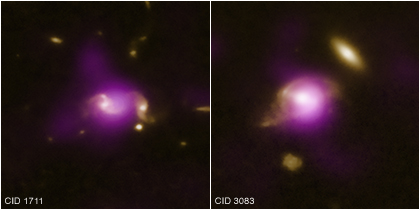All Eyes on Oldest Recorded Supernova
This image combines data from four different space telescopes to create a multi-wavelength view of all that remains of the oldest documented example of a supernova, called RCW 86. The Chinese witnessed the event in 185 A.D., documenting a mysterious "guest star" that remained in the sky for eight months. X-ray images from NASA's Chandra X-ray Observatory and the European Space Agency's XMM-Newton Observatory are combined to form the blue and green colors in the image. The X-rays show the interstellar gas that has been heated to millions of degrees by the passage of the shock wave from the supernova.
The Evolving Universe at NMNH

Credit: Jonathan McDowell, SAO
Close Encounters of the Galactic Kind
Astronomers have used a large survey to test a prediction that close encounters between galaxies can trigger the rapid growth of supermassive black holes. Key to this work was Chandra's unique ability to pinpoint actively growing black holes through the X-rays they generate.
The researchers looked at 562 pairs of galaxies ranging in distances from about 3 billion to 8 billion light years from Earth. They found that the galaxies in the early stages of an encounter with another were more likely than isolated, or "lonelier" galaxies to have actively growing black holes in their cores.
Chandra's Digital Legacy
October is American Archives Month—a time to celebrate the importance of archives across the country. In honor of Archives Month, we're participating in a pan-Smithsonian blogathon. Throughout October we, and other blogs from across the Smithsonian, will be blogging about Chandra's rich archive of astronomical data, issues, and behind-the-scenes projects.
----------------------------------------------------------------------------------------------------------
Concluding our series of Archives Month blog posts, we thought we'd shift our focus towards the future of Chandra's digital legacy. Although the modern marvel of engineering that is the Chandra X-ray Observatory will not last forever, its lasting gift to humanity will be its archive of data. Long after the last bits of X-ray light have found their way to Chandra's detectors, scientists and curious amateurs will still be pouring over Chandra's archival data looking for their particular X-ray needle in the digital haystack.
Women in the High-Energy Universe: Aneta Siemiginowska
Aneta Siemiginowska is an astrophysicist at the Chandra X-ray Center. In addition to her responsibilities for Chandra’s Science Data System group, she is actively involved is exploring the Universe, particularly its black holes and galaxies.
A Summer of Sleuthing Around Hot Data
October is American Archives Month—a time to celebrate the importance of archives across the country. In honor of Archives Month, we're participating in a pan-Smithsonian blogathon. Throughout October we, and other blogs from across the Smithsonian, will be blogging about Chandra's rich archive of astronomical data, issues, and behind-the-scenes projects.
-------------------------------------------------------------------------------------------------------------
This past summer, I interned in the Chandra Education and Public Outreach department at the Smithsonian Astrophysical Observatory (SAO), where I spent several months sleuthing around the Chandra data archives as part of an on-going Astronomy Visualization Metadata (AVM) tagging project https://www.virtualastronomy.org/. AVM is data embedded into each image of astronomical objects that includes information such as the objects coordinates, the instrument and instrument settings used for capturing the image, and a description of the image. The goal of the project is to tag all the press release images from the Chandra X-ray telescope with metadata.
A Middle-Aged Supernova Remnant
G299.2-2.9 is an intriguing supernova remnant found about 16,000 light years away in the Milky Way galaxy . Evidence points to G299.2-2.9 being the remains of a Type Ia supernova, where a white dwarf has grown sufficiently massive to cause a thermonuclear explosion. Because it is older than most supernova remnants caused by these explosions, at an age of about 4500 years, G299.2-2.9 provides astronomers with an excellent opportunity to study how these objects evolve over time. It also provides a probe of the Type Ia supernova explosion that produced this structure.
An Observatory at Your Fingertips
October is American Archives Month—a time to celebrate the importance of archives across the country. In honor of Archives Month, we're participating in a pan-Smithsonian blogathon. Throughout October we, and other blogs from across the Smithsonian, will be blogging about Chandra's rich archive of astronomical data, issues, and behind-the-scenes projects.
-----------------------------------------------------------------------------------------------------------
Digging for Gold in Chandra's Archives
October is American Archives Month—a time to celebrate the importance of archives across the country. In honor of Archives Month, we're participating in a pan-Smithsonian blogathon. Throughout October we, and other blogs from across the Smithsonian, will be blogging about Chandra's rich archive of astronomical data, issues, and behind-the-scenes projects.
--------------------------------------------------------------------------------------------------------------------
Summer at the Smithsonian Astrophysical Observatory in Cambridge, MA, is a perfect time for picking up projects that have been sitting on the back burner for a while. As activities slow down a bit, it's great to dig deeper into the Chandra data archive looking for a hidden gem; and when sifting through over 8 terabytes of data comprising more than 10,000 observations from one of NASA's "Great Observatories," you're bound to unearth more than a few.




